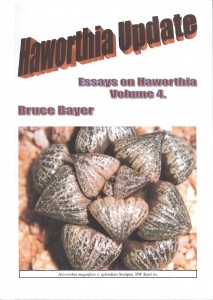In trying to close my long history as a writer about Haworthia, I am anxious that my closing thoughts are more understandable than my opening ones were. Update 4 calls for a “paradigm shift”- for me as much as anyone else. My friend Kobus Venter has written … ”I feel that a lot of important descriptive and analytic content gets lost by reducing the species to this level (of superspecies)”. My intention is completely otherwise. My view has altered in the sense that I recognize and admit that all these new names and descriptions of writers like Masa Hayashi or Ingo Breuer are extremely useful and informative and that we are losing content in arguing and disagreeing about them. My contention now is that our problem lies in the fact that we are trying to explain and understand these complex systems things within the context of a restrictive nomenclatural system that is not designed for the purpose. It is confounded by the problem that as a society we do not understand what species are.
The formal nomenclatural system and the use of Latin binomials is too much for us and it does not work for us as a community. One of my critics went so far as to say that she was “turned-off” by my use of haworthia plant names where I omitted to write the prefix “H” in an article which was about nothing else but Haworthia! This in my view is pedantic nit-picking that the code cannot exclude. The same person wrote that the nomenclatural system is very precise and prevents us from getting in a mess. I think we are in a mess because we try to force it to do something that it is not designed to do. We should be more intent on trying to apply the horticultural system that is intended to cope with cultivars, as is now more evident in the literature. The difficulty we face is that the plants are highly variable IN THE FIELD, and we have yet to do more than scratch the surface of that variability.
The code articles that insist on chronological priority are also to my mind problematical (Dr. Paul Forster wrote…”the current framework (ICBN) for decisions is riddled with flaws…” (So there are other problems too?). This is because an earlier name, which may be based on a wholly atypical plant or population, has to be chosen for a species where a later name may be far more appropriate in terms of all other considerations (including historical use and connotation) for all those variants which, are OR NOT YET considered to, comprise a particular species system.
Gordon Rowley’s complaint (penned in the early ‘70’s” should be recalled. This is against my failure to formally recognise names in my Handbook listing such as “ryderiana”, “revendetii”, “cuspidata” etc. that in my opinion were (ARE) horticultural in origin, and therefore did not belong in a formal botanical system. The problem now is that there is a greater mass of variants which are of field origin and the descriptive boundaries of these variants are far tighter and considerably more difficult to record and document in any naming system. Many of those old names that I dropped are being ignored as new ones are being invented.
Dr. Forster has also expressed the opinion that someone who knows the plants has to make the decisions. If I had known at the start what I now know, I might have done a lot better. My contention is that the community leaders need to address the problem as it is now one of general perception and understanding.
Bruce Bayer
Kuilsriver, RSA ♦

